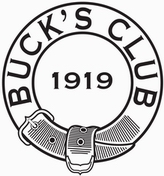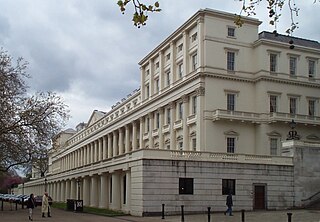
Chelsea Arts Club is a private members' club at 143 Old Church Street in Chelsea, London with a membership of over 4,000, including artists, sculptors, architects, writers, designers, actors, musicians, photographers, and filmmakers. The club was established on 15 November 1890, as a rival to the older Arts Club in Mayfair, on the instigation of the artist James Abbott McNeill Whistler, who had been a member of the older club.

White's is a gentlemen's club in St James's, London. Founded in 1693 as a hot chocolate shop in Mayfair, it is London's oldest club and therefore the oldest private members' club in the world. It moved to its current premises on St James's Street in 1778.

The Devonshire Club was a London gentlemen's club which was established in 1874 and was disbanded in 1976. Throughout its existence it was based at 50 St James's Street. The major Liberal club of the day was the Reform Club, but in the wake of the Reform Act 1867's extension of the franchise, the waiting list for membership from the larger electorate grew to such an extent that a new club was formed to accommodate these new Liberal voters. The clubhouse was on the western side of St James's Street. The original intention was to call it the 'Junior Reform Club', along the model of the Junior Carlton Club formed in 1866, but complaints from the Reform Club's members led it to being named the Devonshire, in honour of its first chairman, the Duke of Devonshire, an aristocrat from a long line of Liberals.

The Arts Club is a London private members' club in Dover Street, Mayfair, founded in 1863 by Charles Dickens, Anthony Trollope, and Lord Leighton among others. It remains a meeting place for men and women involved in the creative arts either professionally or as patrons.

The Naval and Military Club, known informally as The In & Out, is a private members' club located in St James's Square, London. It was founded in 1862 for officers of the Navy and Army. It now also accepts female members, and members who have not served in the armed forces, but continues to observe service traditions.

Buck's Club is a gentlemen's club in London, located at 18 Clifford Street, established in June 1919. P. G. Wodehouse mentions it in some stories and modelled his Drones Club mostly after Buck's. It is probably best known for the Buck's Fizz cocktail, created there in 1921 by its bartender McGarry.

St James's Street is the principal street in the district of St James's, central London. It runs from Piccadilly downhill to St James's Palace and Pall Mall. The main gatehouse of the Palace is at the southern end of the road; in the 17th century, Clarendon House faced down the street across Piccadilly from the site of what is now Albemarle Street.

The Cobden Club was a society and publishing imprint, based in London, run along the lines of a gentlemen's club of the Victorian era, but without permanent club premises of its own. Founded in 1866 by Thomas Bayley Potter for believers in Free Trade doctrine, it was named in honour of Richard Cobden, who had died the year before. Potter was honorary secretary of the Cobden Club from its foundation until his death in 1898.

Boodle's is a gentlemen's club in London, England, with its clubhouse located at 28 St James's Street. Founded in January 1762 by Lord Shelburne, who later became Prime Minister of the United Kingdom and then 1st Marquess of Lansdowne, it is the second oldest private members' club in London and in the world.

The Turf Club is a London gentlemen's club, established in 1861 as the Arlington Club. It has been located at 5, Carlton House Terrace since 1965.

The Canning Club is a gentlemen's club based in London, formerly named the Argentine Club, founded in 1911, and is for those with a particular link to, or special interest in, Argentina and other Latin American countries.

The Bath Club was a sports-themed London gentlemen's club in the 20th century. It was established in 1894 at 34 Dover Street. Its swimming pool was a noted feature, and it is thought that the swimming pool of the fictional Drones Club was based on this. It is also where Princess Margaret and Queen Elizabeth II learned to swim. It was one of the few gentleman's clubs that admitted women. Sir Henry "Chips" Channon was a member. Mark Twain stayed here when he visited London. Guglielmo Marconi stayed here as well when he visited London.

The Junior Carlton Club was a London gentlemen's club, now dissolved, which was established in 1864 and was disbanded in 1977.
The Junior Constitutional Club was a political London gentlemen's club founded in 1887, and located at 101 Piccadilly. It was aligned to the Conservative party, with members having to pledge support. Heavy over-subscription for the Constitutional Club which had opened in 1883 led to the creation of a further mass-membership Conservative club.

The Cavalry and Guards Club is a London gentlemen's club, at 127 Piccadilly, situated next to the RAF Club.

The Cavalry Club was a London gentlemen's club, which was established in 1890. In 1975, it merged with the Guards' Club, and became the Cavalry and Guards Club, which still exists today.

The Bachelors' Club was a London gentlemen's club in the late nineteenth and early twentieth century, now defunct. As the name suggests, membership was only open to bachelors. The club had a reputation for having a markedly younger membership than many other Edwardian clubs, and given the high-spirited antics which sometimes ensued on the premises, it was cited as an influence on the fictional Drones Club, in some of P.G. Wodehouse's earlier stories. A persistent rumour circulated throughout its existence, and reached wider circulation in the 1920s, that some of its membership were gay - then both illegal and publicly frowned upon – and it soon became superseded by Buck's as the young man's club in London, being forced to close shortly thereafter.

The City of London Club was established in 1832 and is the oldest of the gentlemen's clubs based in the City of London. Its Italian Palladian-style building was designed by English architect Philip Hardwick. Prince Philip, Duke of Edinburgh, was its royal patron.

The Public Schools Club is a former London gentlemen's club.

The Flyfishers' Club is a gentlemen's club in London, England, which was founded in 1884 for enthusiasts of flyfishing. In 1894, the club had more than three hundred members, while in 1984, this number had risen to between eight and nine hundred members.

















